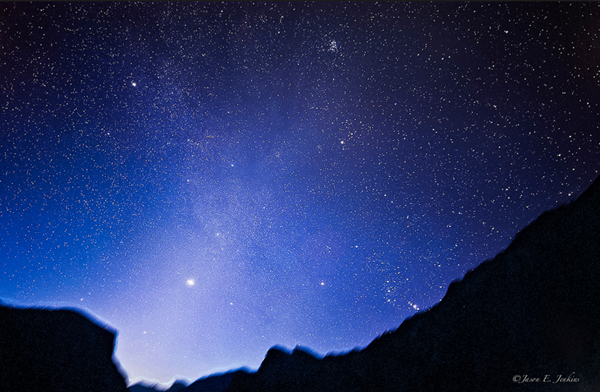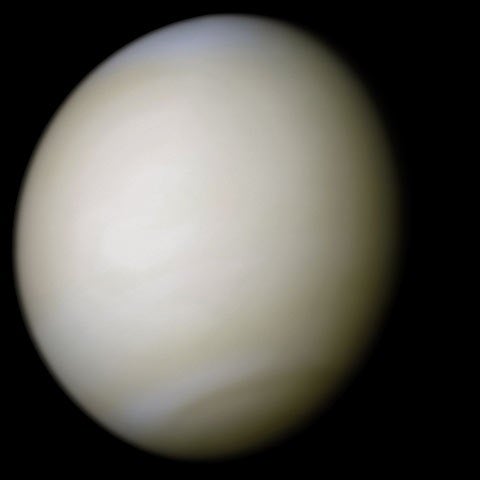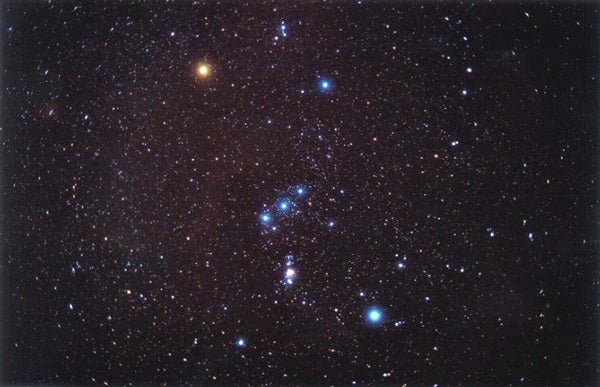Friday, February 10
Full Moon arrives officially at 7:33 p.m. EST, but it looks completely illuminated most of the night. You can find it rising in the east at sunset and peaking in the south shortly after midnight local time. It dips low in the west by the time morning twilight begins. The Moon spends the night in western Leo, not far from the Lion’s brightest star, 1st-magnitude Regulus. Look carefully this evening and you should notice the distinct dusky shading of a penumbral lunar eclipse over Luna’s northern half. The eclipse peaks at 7:44 p.m. EST, when 99 percent of the Moon lies within our planet’s light outer shadow.
Saturday, February 11
Saturn rises more than three hours before the Sun and climbs some 15° high in the southeast by the time morning twilight begins. The ringed planet shines at magnitude 0.5 among the much fainter background stars of Ophiuchus the Serpent-bearer. When viewed through a telescope, Saturn shows a 16″-diameter disk surrounded by a stunning ring system that spans 36″ and tilts 27° to our line of sight.
Sunday, February 12
The next two weeks offer observers an excellent chance to see the zodiacal light. From the Northern Hemisphere, late winter and early spring are great times to observe this elusive glow after sunset. It appears slightly fainter than the Milky Way, so you’ll need a clear moonless sky and an observing site located far from the city. Look for the cone-shaped glow, which has a broad base and points nearly straight up from the western horizon, after the last vestiges of twilight have faded away. The Moon stays out of the early evening sky until February 28.
Monday, February 13
Although asteroid 4 Vesta reached opposition and peak visibility in mid-January, the brightest minor planet of 2017 still shines at magnitude 6.8 and shows up quite easily through binoculars. To find the minor planet, start at magnitude 1.2 Pollux in northern Gemini and then drop 2.4° southwest to magnitude 4.1 Upsilon (u) Geminorum. Vesta lies 1.4° due south of Upsilon this evening.
Tuesday, February 14
In what seems a fitting tribute, the planet named after the Roman goddess of love shines brilliantly in the evening sky on Valentine’s Day. Venus gleams at magnitude –4.8 and shows up easily in the west-southwest within a half-hour after sunset. It grows even more prominent as darkness settles over the landscape. The planet lies among the background stars of Pisces the Fish, a region that stands some 30° high an hour after the Sun goes down and doesn’t set until 9 p.m. local time. When viewed through a telescope this evening, Venus appears 38″ across and 29 percent illuminated.
Wednesday, February 15
Jupiter rises around 10 p.m. local time and climbs highest in the south about 90 minutes before morning twilight commences. The giant world shines at magnitude –2.3 against the backdrop of central Virgo, some 4° north of that constellation’s brightest star, 1st-magnitude Spica. And this evening, the waning gibbous Moon rises just a half-hour after the planet and follows it across the sky the rest of the night. Even a small telescope reveals Jupiter’s 41″-diameter disk and four bright moons.
Thursday, February 16
Mars continues to put on a nice show these February evenings. It appears 25° high in the west-southwest once twilight fades to darkness, though it’s easier to find by looking 7° (about one binocular field) to the upper left of brilliant Venus. The magnitude 1.2 Red Planet currently lies among the background stars of Pisces the Fish. A telescope shows the world’s 5″-diameter disk, but you likely won’t see any surface detail.
Friday, February 17
Venus reaches greatest brilliancy today, when it shines at magnitude –4.8 (magnitude –4.85, to be more precise). That makes it 10 times brighter than the evening sky’s second-brightest object, Jupiter. Although today marks the inner planet’s official peak, it doesn’t dip below magnitude –4.8 until early March.
Jupiter reaches aphelion at 2 a.m. EST. This is the point in its 12-year orbit around the Sun where it lies farthest from our star, at a distance of 507.2 million miles (816.3 million kilometers).
Saturday, February 18
Last Quarter Moon occurs at 2:33 p.m. EST. Look for it either before dawn this morning (when it lies among the background stars of Libra and looks slightly more than half-lit) or after it rises around 1:30 a.m. local time tomorrow (when it stands near the Scorpius-Ophiuchus border and appears as a fat crescent).
If the Last Quarter Moon looks a little smaller to you today, it may not be your imagination. Our satellite reaches apogee, the farthest point in its orbit around Earth, at 4:14 p.m. EST. It then lies 251,268 miles (404,376 kilometers) from Earth’s center.
Sunday, February 19
One of the sky’s largest asterisms — a recognizable pattern of stars separate from a constellation’s form — occupies center stage on February evenings. To trace the so-called Winter Hexagon, start with southern Orion’s luminary, Rigel. From there, the hexagon makes a clockwise loop. The second stop is brilliant Sirius in Canis Major. Next, pick up Procyon in the faint constellation Canis Minor, then the twins Castor and Pollux in Gemini, followed by Capella in Auriga, Aldebaran in Taurus, and finally back to Rigel.












